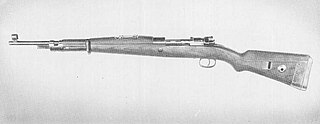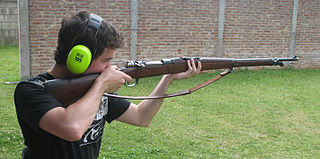
The Gewehr 98 is a bolt-action rifle made by Mauser for the German Empire as its service rifle from 1898 to 1935.
The vz. 24 rifle is a bolt-action carbine designed and produced in Czechoslovakia from 1924 to 1942. It was developed from the German Mauser Gewehr 98 line, and features a similar bolt design. The rifle was designed in Czechoslovakia shortly after World War I, to replace the Vz. 98/22, also a Czech derivative of the Gewehr 98. The vz. 24 featured a 590 mm (23.2 in) barrel which was shorter and considered more manageable than the 740 mm (29.1 in) Gewehr 98 barrel. The vz. 24 was chambered in 7.92×57mm Mauser like its predecessors.

The Karabinek wz.29 was a Polish bolt-action short rifle based on the German Kar98AZ. Identifying attributes include a 98/05 style mast bayonet lug ending directly beneath the front sight and winged protective ears to either side of the front sight blade. Cavalry models featured a turned-down bolt handle, and early versions had a stacking hook near the end of the stock on the right side.

The Gewehr 88 was a late 19th-century German bolt-action rifle, adopted in 1888.

The Mauser Model 1871 adopted as the Gewehr 71 or Infanterie-Gewehr 71, or "Infantry Rifle 71" was the first rifle model in a distinguished line designed and manufactured by Paul Mauser and Wilhelm Mauser of the Mauser company and later mass-produced at Spandau arsenal.

The puška vz. 33 was a Czechoslovak bolt-action carbine that was based on a Mauser-type action, designed and produced in Československá zbrojovka in Brno during the 1930s in order to replace the obsolete Mannlicher vz. 1895 carbines of the Czechoslovak četnictvo (gendarmerie). The manufacturer's designation was vz. 16/33. Another version, the Vz. 12/33, was also produced for the Latin American market.

"Swedish Mausers" are a family of bolt-action rifles based on an improved variant of Mauser's earlier Model 1893, but using the 6.5×55mm Swedish cartridge, and incorporating unique design elements as requested by Sweden. These are the m/94 carbine, m/96 long rifle, m/38 short rifle and m/41 sniper rifle. Production began in 1898 at Carl Gustafs stads Gevärsfaktori in Eskilstuna, Sweden.
The Type Chiang Kai-shek rifle, also known as the Generalissimo rifle, and Type 24 (二四式), named after the Chinese Generalissimo Chiang Kai-shek, was a Chinese-made copy of the German Standardmodell rifle, the forerunner of the Karabiner 98k. Preproduction of the Chiang Kai-shek rifle started in 1935. It was designated the Type 79 by the Chinese Communists.
The Mondragón rifle refers to one of two rifle designs developed by Mexican artillery officer General Manuel Mondragón. These designs include the straight-pull bolt-action M1893 and M1894 rifles, and Mexico's first self-loading rifle, the M1908 - the first of the designs to see combat use.
The Mauser Model 1893 is a bolt-action rifle commonly referred to as the Spanish Mauser, though the model was adopted by other countries in other calibers, most notably the Ottoman Empire. The M1893 was based on the experimental M1892 rifle, which Paul Mauser developed for the Spanish Army as part of a program to correct deficiencies in the earlier 1889, 1890, and 1891 series of Mauser rifles. The M1893 introduced a short staggered-column box magazine that fit flush with the bottom of the stock; the magazine held five smokeless 7×57mm Mauser rounds, which could be reloaded quickly by pushing a stripper clip from the top of the open bolt.

The FN Model 1924 series is a line of Mauser Gewehr 98 pattern bolt-action rifles produced by the Belgian Fabrique Nationale. They are similar to the Czech vz. 24 rifle, however have an intermediate length action, featuring open sights, 7.65×53mm, 7×57mm or 8×57mm IS chambering, Long rifle, Short Rifle and carbine-length barrels, hardwood stocks, and straight or curved bolt handles. This pattern rifle was discontinued from production and was no longer offered after 1932 being totally replaced by the 1930 pattern.

The Mauser Model 1889 is a bolt-action rifle of Belgian origin. It became known as the 1889 Belgian Mauser, 1891 Argentine Mauser, and 1890 Turkish Mauser.

The Mauser Model 1895 is a bolt operated magazine fed rifle using the 7×57mm Mauser cartridge. It was exported to many overseas powers, including the Chilean forces which adopted as the Fusil Mauser Chileno Modelo 1895. It is the first major modification of the Mauser Model 1893 and was produced by Deutsche Waffen und Munitionsfabriken, known as DWM, and Ludwig Loewe Company from 1895 to 1900.
The Mukden Arsenal Mauser also known as the Model 13 Mauser and Liao Type 13 was a rifle that implemented characteristics of both the Mauser Type 4 and the Arisaka rifles. They were mostly built in the Mukden arsenal in Manchukuo.
The Standardmodell rifle is a bolt-action rifle designed to chamber the 7.92×57mm Mauser cartridge. The rifle was developed in 1924 but entered full-scale production in 1933. Officially designed for export and German security guards, it was used by the paramilitary Sturmabteilung (SA) and Schutzstaffel (SS). Export variants were used in South America, Ethiopia, China and the Iberian Peninsula. The carbine version of this rifle was almost identical with the Karabiner 98k that became the standard German service rifle during World War II.
The Steyr Model 1912 were Gewehr 98 pattern bolt-action battle rifles produced by Steyr before World War I. They were designed for export market. During the war, they were also used by the Austro-Hungarian Army.

The Argentine Mauser Model 1909 were Gewehr 98 pattern bolt-action battle rifles designed for the Argentine Army. They were produced both in Germany and in Argentina.
The Mauser Model 1908 were series of Gewehr 98 pattern bolt-action rifles. First produced by Deutsche Waffen und Munitionsfabriken (DWM) and Mauser, they were exported to Uruguay and Brazil. In this latter country, Brazilian War Material Industry produced upgraded versions until the rifle was replaced by the FN FAL.
The Mauser Model 1902 was a Mauser bolt-action rifle, designed for Mexico. It was similar to the Mauser Model 1895 but used the Gewehr 98 action.
 Bolivia: ~4,000 Modelo 1907 rifles and 1,000 Model 1907 carbines made by DWM in 7.65×53mm Mauser, [17] used during the Chaco War [18]
Bolivia: ~4,000 Modelo 1907 rifles and 1,000 Model 1907 carbines made by DWM in 7.65×53mm Mauser, [17] used during the Chaco War [18]  Brazil: 7mm DWM Model 1907 rifles. [19] A Model 1907 carbine was also sold by DWM to the cavalry of the military police. [6]
Brazil: 7mm DWM Model 1907 rifles. [19] A Model 1907 carbine was also sold by DWM to the cavalry of the military police. [6]  China: Model 1907, Type 1 and Type 4.
China: Model 1907, Type 1 and Type 4. Colombia: DWM Model 1904 [20]
Colombia: DWM Model 1904 [20]  Chile: 300 DWM Model 1907 short rifle
Chile: 300 DWM Model 1907 short rifle Ecuador: Model 1907 [4]
Ecuador: Model 1907 [4]  El Salvador: Model 1904 [21]
El Salvador: Model 1904 [21]  German Empire: Chinese Model 1907 [12]
German Empire: Chinese Model 1907 [12]  Iran: 1,500 Mauser Model 1904/1907 [22]
Iran: 1,500 Mauser Model 1904/1907 [22]  Paraguay: Fusil Modelo 1907 Paraguayo, Carabina Mauser Paraguayana Mo. 1907, Fusil Modelo 1927, Mosqueton Modelo 1927 and Carabina Modelo 1927, [9] [1] all used during the Chaco War [18]
Paraguay: Fusil Modelo 1907 Paraguayo, Carabina Mauser Paraguayana Mo. 1907, Fusil Modelo 1927, Mosqueton Modelo 1927 and Carabina Modelo 1927, [9] [1] all used during the Chaco War [18]  Thailand: slightly heavier and longer Mauser Model 1904 [5]
Thailand: slightly heavier and longer Mauser Model 1904 [5] 








